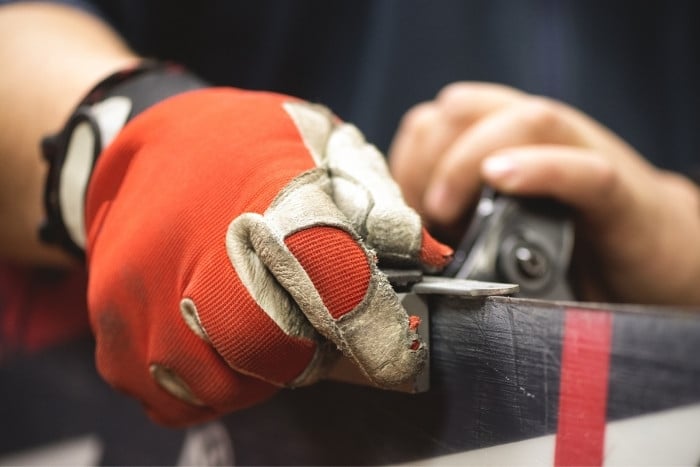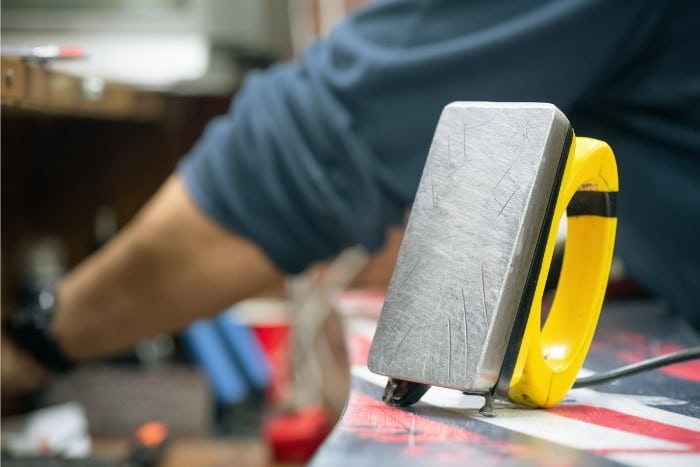One of the most common barriers to entry in snowboarding is the cost of a snowboard. And the costs don’t stop there; once you have the board, there are additional costs to keep it maintained and repair any dings. But how much should it cost to repair your snowboard?
It should cost between ten and one hundred dollars to fix your snowboard, depending on which part of your board needs repair and the severity of damage. Fixing multiple breaks in multiple areas can increase the price. Full-service tune-ups are available for close to one hundred dollars.
Snowboard repair can have extreme variations in price depending on the break you are facing. A snowboard is not made of a single piece of material, and repairs will differ in technique and price.
Snowboard Repair Cost
The cost of snowboard repair depends on what is being fixed and the prices of a particular repair shop.
In case you want to fix your broken snowboard yourself, here is our DIY guide on snowboard repair.
The most common minor snowboard damages are dented edges or gouges taken out of the base.
Minor scratches to the base and edges can often be repaired by a simple tune-up.
A typical tune-up covers two areas of repairs, sharpening the edges and waxing the base.
1. Edge Repair Cost
Hitting the edge of your board off a pole, rock, chairlift, or even improper handling when travelling can result in the edges getting a ding or divot.
Without repair, these can catch on the snow, resulting in loss of balance and falling, or at a minimum creating slowness when riding.
Dulling burrs on an edge can be done with a file, and a sharpening tool can even the edges to their original smooth state.
Edges alone can run $25-$45 for professional service.

2. Base Repair Cost
Many different service techniques are available to repair a snowboard’s base. The type of service needed depends on the condition of your base.
With regular wear and tear, including some more minor gashes to the base, you will need a fresh wax applied.
If the tear in the base is only at polyethylene level, you only need regular wax.
A small chunk taken out of this base will not impact the performance of your board with a standard wax.
If there is an impact on the performance, or the gouge goes through the polyethylene to the core of the board, it will need to be repaired using Ptex.
Ptex is a form of polyethylene that is melted to fill in the cracks on your base, making it smooth and resistant to water damage.
Depending on the selected option, a wax can range from $5 to $85. Additional costs can be incurred from requesting or requiring Ptexing.
Waxing Options and Their Costs
You’ll often see a few different options for waxing available at the repair shop. Not all shops will have all options available.
Still, most shops should have some essential maintenance options available or would be happy to take a look and refer you to another shop that could help you out.
1. Machine Wax $5-$20
A machine is the easiest way to reapply wax. It applies and distributes hot wax to your board while removing excess wax.
2. Hand Wax $15-30
A hand wax is a traditional way to wax a snowboard. A person will use an iron to apply wax to the board’s base.
This method works well if your base needs additional attention to trouble areas.
3. Machine Grind $30-$65
This service uses a belt grinder to take the first layer off the bottom of your board.
It flattens the base, sharpens the edges, and allows the wax to be applied efficiently and evenly.
4. Stone Grind $45-$85
A stone grind is a more precise version of the machine grind. It efficiently evens the base of your board before applying the wax.
Often repair shops will have a combined option of a full tune, which could include a stone grind for the base, machine grind for the edges, machine wax, and hand wax to add finishing touches.
Repairing The Top Sheet on Your Snowboard
The top of your snowboard can get damaged in similar ways to the base, and the edges, and often these breaks occur in tandem with damage to the edges.
Damaging the top sheet of your snowboard makes it easy for water to get in.
Once the water enters the board, it will expand in cold conditions, which could damage the board even further.
These breaks can be repaired with epoxy, specifically water-resistant cold-weather epoxy.
Epoxy is a resin that starts as a liquid but forms a chemical bond that hardens it. Different epoxies are designed to hold firm in different conditions.
Since a snowboard gets cold and wet often, repairing a top sheet break should be done with water-resistant cold-weather epoxy.
A shop will charge roughly $10-$25 per damaged area.
Repairing Your Snowboard on Your Own
All of these breaks, while remaining cheaper than a new board, can still add up.
If you’ve got the time and are comfortable doing the repairs yourself, it is often much cheaper to purchase the materials on your own.
1. Epoxy
Epoxy can be found online or at any hardware store. A two-tube kit (to keep the chemicals apart before the bond is created) can go for as little as $6
2. Ptex
You can expect to pay about $10 for a stick or pack of multiple sticks of Ptex at a specialty shop.
3. Wax
Hot wax that can be used multiple times will cost you around $15-$25.
4. Wax Kit/Iron
If you’re looking at waxing your board yourself, you should look into purchasing a snowboard waxing kit.
These can range from $30-$70, and you’ll get proper cleaning instruments and a flat iron designed for waxing a snowboard.
With that said, these irons work the same as a typical clothes iron you can get for about $8.
I used an iron I got at Walmart on my snowboard for eight years with no issues.
Don’t intend to use it for clothes after as it will be covered in wax, but if you’re looking for something budget-friendly, it will get the job done.

5. Edge Tuning
An edge sharpener can go for $20-$50, depending on the brand.
This will last multiple snowboards. However, you can also use a metal file commonly found at hardware stores.
When used properly, a metal file can tune your edges well for $5. Similar to a knife sharpener, using the file parallel to the edge will sharpen it to a point.
At the same time, a more perpendicular approach will dull the edge.
Doing this incorrectly will damage the edges, so be careful and seek help from someone with experience.
Once you’re purchased each of these and understand how to use them, you’re set to fix any minor break on your snowboard’s edges for roughly $44 upfront.
For a comprehensive guide on how to repair those yourself, read our article on snowboard chip repair.
Final Thoughts
The severity of the damage to your snowboard will determine how much you would need to spend to repair it.
Breaks should be addressed before they worsen, and a professional can help to correctly identify and perform the repair.
If you’d like to do the repair yourself to save some money, there are a few readily available materials and tools that you can purchase that won’t break the bank.
